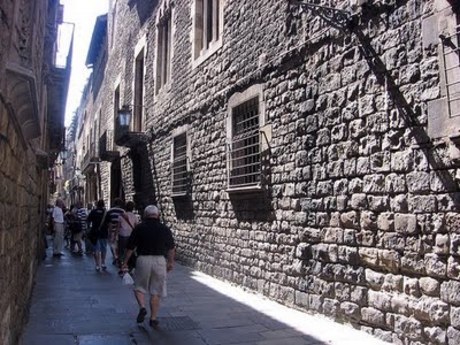Carrer Montcada
Carrer Montcada is a narrow street typical of Barcelona's Ciutat Vella (old district). During the heady days of Catalonia's empire, Carrer Montcada was the top spot for Barcelona's rich aristocrats and merchants to own a luxury pad.
The street called Carrer de Montcada is today the most important area of mediaeval civic architecture in the city.
It starts with the Romanesque Marcus chapel (12th century) and finishes at Plaça del Born. It used to be all one single street until the 19th century, when it was divided into two by the opening of Carrer Princesa in 1853.
Its name derives from the important Montcada family from Barcelona who, it appears, received the land in the 12th century for the support lent to King Ramon Berenguer IV by Guillem Ramon de Montcada during the conquest of Majorca.
The first homes outside the city walls emerged in the mid-12th century. The street linked the Bòria commercial district with the old sailing quarter of Vilanova del Mar, leading to the creation of the Ribera district. At the end of that century, the area was incorporated into the new city walls, experiencing its greatest splendour from the 15th to the 16th century. It was then an aristocratic street inhabited by noble families and rich merchants who had earned their fortune from the sea trade.
At the end of the 19th and in the early 20th century, the street underwent significant alterations and a decline in the area’s residential nature. The street was declared an artistic-historical heritage site in 1947.
Most of these palaces are still extraordinarily well-preserved, making Carrer Montcada one of Barcelona's most historically atmospheric streets, mixing delightful Middle Age and Renaissance architecture. These days the palaces now house cafes, museums and souvenir shops, making Carrer Montcada one of El Born's most pleasant streets to spend a morning.
One of the highlights of Carrer Montcada is this huge collection of Picasso's work, so ample, it's housed in five of the street's palaces. The Museu Picasso is one of Barcelona's most visited museums, with constant queues around the block.
Barcelona’s Carrer Montcada is lined with a succession of medieval, Renaissance and baroque palazzos, their majestic doorways opening to reveal their beautiful courtyards of venerable stone. They bear witness to the rich and glorious past of medieval Barcelona’s main street which was home to the city’s nobles.
The origins of Carrer Montcada can be traced back to the 12th century when the dynasty of the Barons of Montcada were given the land by the Count Kings of Catalonia as a token of gratitude for the support they had given to King Ramon Berenguer IV in the conquest of Tortosa. During this time, Barcelona’s noble and merchant classes, who had made their fortunes at sea, started building their magnificent homes here. They are mansions or palazzos, most of them constructed in the Catalan Gothic style around a central courtyard which leads to the first floor via a beautiful staircase. The street still retains examples of medieval palazzos, such as the Palau Aguilar, Palau Meca and Palau Baró de Castellet, which houses the Museu Picasso of Barcelona, and Renaissance ones, including the Palau de Cervelló and the beautiful baroque Palau Dalmases.
As you walk along Carrer Montcada, beneath the galleries with their vaulted ceilings, you’ll relive the atmosphere of medieval Barcelona’s glorious past, while visiting art galleries and museums. In addition to the Museu Picasso, you'll find the Museu d’Art Precolombí, in the Palau Nadal, or the Galeria Maeght, in the Palau Cervelló.
Opposite the Picasso Museum, in the Marquesos de Liió Palace, is the Textile Museum, which is also home to the wonderful Textil Cafe. The textile industry played an important role in Barcelona's 18th Century economic and cultural rebirth. Also along Carrer Montcada is the Barbier-Mueller Precolombian Art Museum, with interesting artifacts from pre-colonial Latin America.
Carrer Montcada has some interesting arty souvenir shops and a couple of excellent tapas eateries. There's the Basque pintxos emporium Euskal Etxea. And traditional tapas, free-flowing cava and agreeably little elbow space in El Xampanyet, directly opposite.The street is a dream for the tourists out for sightseeing and cultural travel.
The Museu Picasso end of the street can get very crowded in peak hours, so try and get there early in the morning. Late at night can also be a delightful way to take in its centuries of history at your leisure.
El Born is served by Jaume I metro station (yellow line), Urquinaona (yellow and red lines) and Arc de Triomf (red line). You can get there via direct flight to Barcelona or to Girona, Reus or Lleida–Alguaire. Carrer Montcada is very special place with rare atmosphere. Don't forget to visit it after your flight to Barcelona. It is easily accesible from the Old Town and offers beautiful sights.




